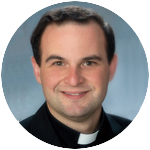
Father Eric J. Banecker
3. 10. 7. 40. What do they have in common? They’re key Biblical numbers. Think about it – those numbers show up all over the Scriptures in very significant moments. Early Christian authors were wild about numbers, and they would read intricate meanings into these key figures.
Most people don’t think of the number 50 as being quite so significant.
On Sunday evening, March 15, the Centers for Disease Control released a new set of national guidelines, urging the cancellation of all events of more than 50 people. (Of course, just hours later on Monday, President Trump cautioned against any gathering of more than 10. Which essentially limits us to private homes. More on that another day).
[hotblock]
But when I heard that rule of 50 from the CDC, I thought about the story of Jesus feeding the 5,000. There’s a fascinating little detail in there that’s worthy of reflection (from Luke 9):
When the apostles returned, they explained to him what they had done. He took them and withdrew in private to a town called Bethsaida. The crowds, meanwhile, learned of this and followed him. He received them and spoke to them about the kingdom of God, and he healed those who needed to be cured. As the day was drawing to a close, the Twelve approached him and said, “Dismiss the crowd so that they can go to the surrounding villages and farms and find lodging and provisions; for we are in a deserted place here.”
He said to them, “Give them some food yourselves.” They replied, “Five loaves and two fish are all we have, unless we ourselves go and buy food for all these people.” Now the men there numbered about five thousand. Then he said to his disciples, “Have them sit down in groups of [about] fifty.” They did so and made them all sit down.
I’ve long wondered why this seemingly insignificant request was made. What does their sitting in smaller groups have to do with the miracle? Were they all practicing an ancient form of social distancing?
I don’t believe so. Jesus intended this miracle to be about more than simply feeding physical hunger. This miracle of feeding the 5,000 is the only one to appear in all four Gospels – and is the most direct prefiguration of the Eucharist.
The miracle presents the church in a mysterious microcosm: Jesus presides and breaks the bread; then he gives the loaves and fish to the apostles; the apostles in turn give the food to the people, who happen to be assembled in groups of about 50. Yet despite their groupings, they are sharing one meal, a miraculous meal brought about by the Incarnate Word of God.
I’ve stood in crowds of over a million people. I was ordained a priest in front of 1,500 people actively participating in Mass — an unforgettable experience. I’ve been to Phillies playoff games and celebrated with 45,000 people in unison. Those are unique experiences.
Yet so many of life’s formative, life-changing moments happen in much smaller affairs. This smaller size allows for the possibility of real community, a real sharing of life. What if, at every Sunday Mass, we were worshiping not with a crowd of strangers, but with an assembly of those who are known to us, of people with whom we can share joys, sorrows, hopes, and fears?
Certainly, a regular group of 50 would make that much more possible than the groups of thousands that often come through our doors on a given weekend, scattered among several Masses. And, as the miracle is at pains to show, the 5,000 are in no way separated by their being grouped together. The Holy Spirit ultimately is the principle of unity in the church, and through the liturgy, the Spirit mysteriously gathers us all as one, whether we are in China, Rome, Ethiopia, or Philadelphia.
One of the interesting aspects of Jesus’ public ministry is his skepticism of crowds. Even as many flocked to him, Jesus often went away by himself, or just with his chosen circle of collaborators. When the crowds did follow him, he would respond with “hard sayings,” such as the Bread of Life discourse (John 6) or the great paradox (“anyone who wishes to come after me must deny himself, take up his cross, and follow me”).
Jesus was not obsessed with big numbers or grand gestures. What he thirsted for was faith. What he understood was that a small, dynamic, faithful band of disciples could transform the world more effectively than a large, half-hearted entourage.
In these days of Lent, and in this time of unprecedented change in daily life, Jesus is offering us the grace to be renewed in the fervor of discipleship and to appreciate anew the value of smaller gatherings of people.
***
Father Eric J. Banecker is parochial vicar at St. Pius X Parish, Broomall.
PREVIOUS: Keep reverence for Christ in Communion, in hand or tongue
NEXT: Our Christian calling and social distancing



Share this story